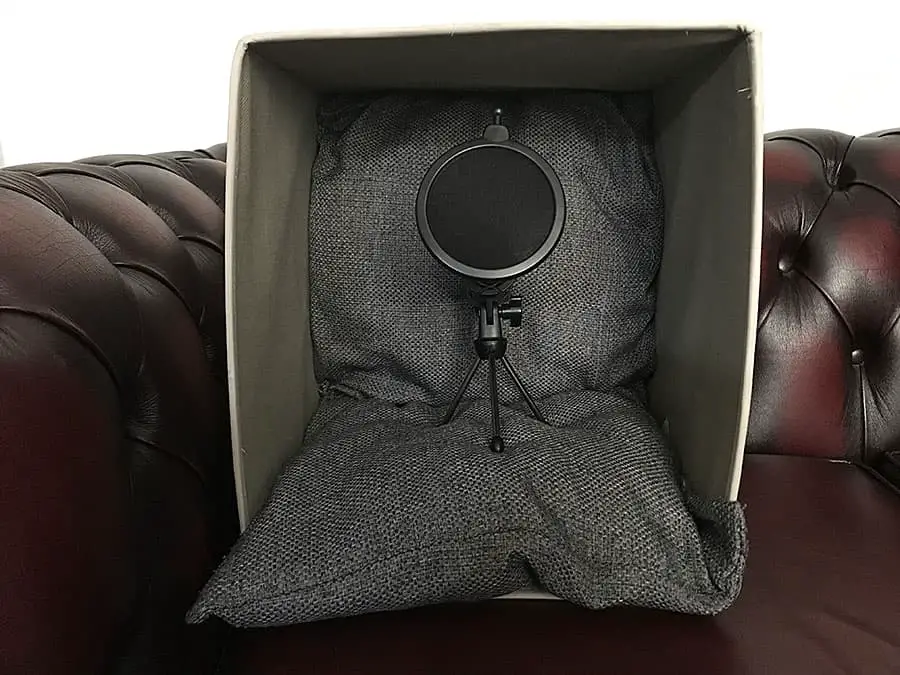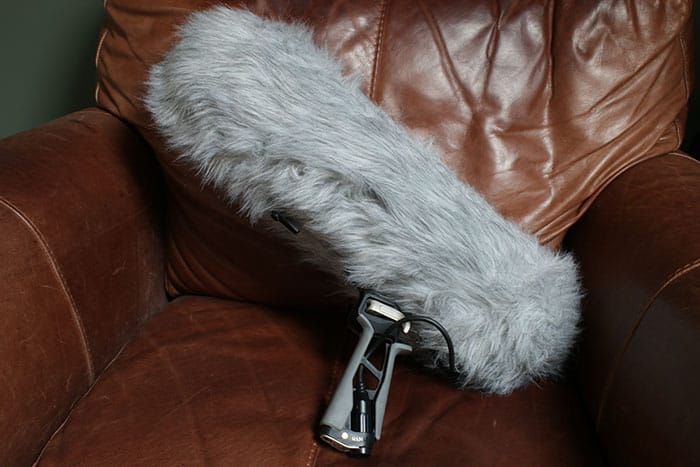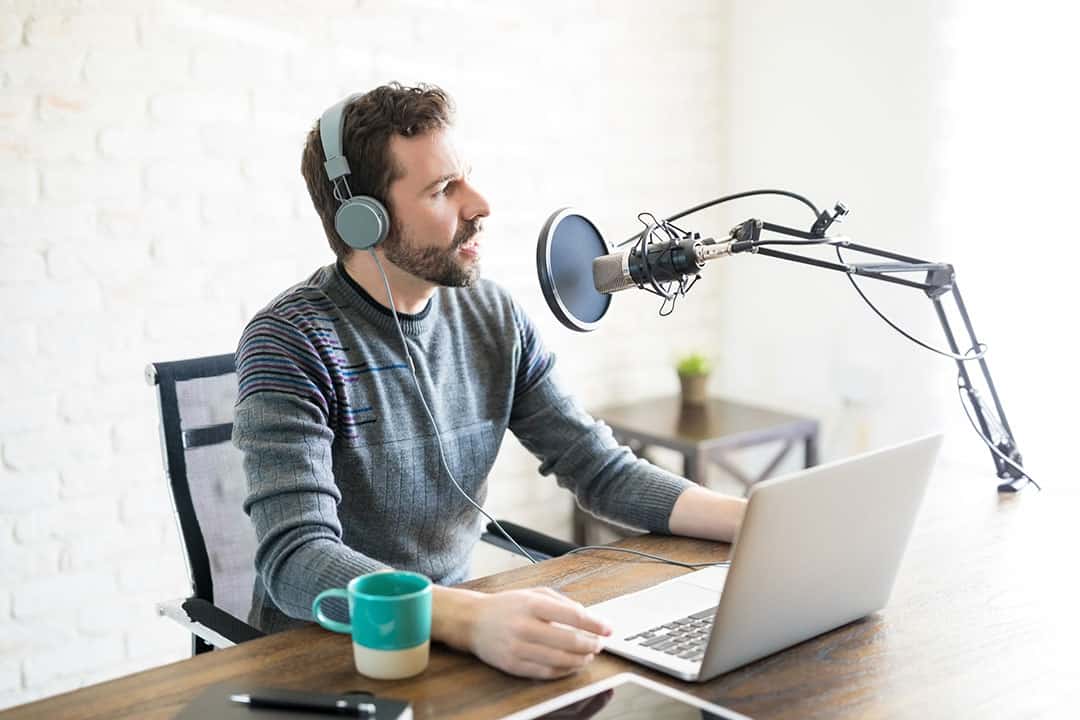If you’re like me, you live in a busy house and finding a quiet place to record your podcast isn’t straightforward. Kids, dogs, neighbors, washing machines and all manner of other noisy things can ruin your production.
In this guide I’ll share some things to think about when trying to find those quieter areas and also suggest some places that you may not have thought of.
Table of Contents
Gear Tips
Before we get into the location recommendations, there are a few tips relating to gear and setup that’s worth covering.
The first one is about portability, particularly if you’re recording in your home. Having a permanent setup is great if you’re ideally located for recording, but there are times when you’ll need to move around to get away from the noise.
Exactly how to build a portable podcast setup is a separate topic but one that we’ve covered before in our article Portable Podcast Equipment – Gear for Recording on Location so take a look through that if you need some guidance.
Another tip when it comes to equipment is to use a dynamic microphone. The likelihood is that the various places in your house which might be the quietest are not sound treated and therefore echo could be an issue.
Condenser mics tend to be a lot more sensitive and are therefore less forgiving in less than ideal surroundings. A low sensitivity dynamic mic will allow you to achieve a nice sound in a wider variety of locations.
Again, we’ve covered this topic in more detail in our article about condenser vs dynamic mics for podcasting.
Because you might need to move from room to room, having some sort of portable vocal booth (either shop bought or homemade) would be an advantage. Combined with the dynamic mic mentioned above, you should be able to achieve a nice warm sound regardless of the lack of sound treatment in the room.
The image below is what I used when I first started podcasting and realised that echo was an issue in the room I used for recording. I bought the great value Shure SM57 (Amazon link) dynamic microphone, a cheap stand with an integrated pop filter and then used an Ikea storage box stuffed with cushions to dampen the echo. It looks a bit primitive, but the results were surprisingly good.

Of course, if you wanted something less DIY, you could look at something like is shown in the image below. It is cost effective and uses acoustic foam.

Room Tips
If you don’t want to invest in a vocal booth or even attempt to hash something together yourself, there are some things to think about when choosing the best room to record your podcast.
The first is the size of the room and what’s in it. A large room with not a lot in it could be problematic from a sound quality perspective. It’s likely to echo and you could end up with a very hollow sound.
The other thing to think about is what’s in the room. Are there any large reflective surfaces such as full-length windows, a large TV or mirror, or a wooden/laminate floor? These will bounce sound waves all around the room and could cause you issues.
The ideal room is one which is carpeted, contains a lot of soft furnishings (large material covered sofas and chairs, rugs, cushions etc), a minimal amount of highly reflective surfaces and where there are unavoidable reflective surfaces such as windows, a heavy pair of curtains which can be drawn to absorb more of the sound waves.
Position yourself towards a softer, more absorbent background if possible.
Ideas for Quiet Places to Record
Now that we’ve covered gear and some tips for getting the best sound regardless of location, let’s go over some ideas for where you could record your podcast which are likely to be quiet.
We’ll start with some ideas in the home and then move onto ideas which are outside the home if your home is just too noisy.
Your Closet
Sounds odd doesn’t it? The truth is that all those hanging clothes it makes for a great space to minimise sound reflections and echo, which will give you a warmer and more studio like sound.
Of course, a lack of sound reflection doesn’t mean a lack of noise but with a closet, it’s likely to be inside a bedroom which means that you can shut both doors to keep any noise to a minimum.
If there are gaps under the doors you can roll up a towel or use a draft excluder to help stop the noise leaking through.
You may still have some reflective surfaces in your closet – mirrors, sets of drawers and of course the door all have the potential to bounce those sound waves back to your mic and therefore compromise your audio quality. However, with the large amount of clothes to absorb the waves as they bounce around this risk will be reduced.
Still try to think about where you position yourself and do some tests in various places inside the closet to see which gives you the best result.
If there are still issues with echo, you could simply move some of the clothing around to try and keep it to a minimum. Hanging a long coat over the door for example could stop some of the reflection of the shiny wooden surface.
Under the Duvet
Continuing the theme of looking for slightly odd but good places to record your podcast in the home, what about under your duvet? Associated more with a lazy Sunday morning or hiding during a horror movie, the effect on your audio when there are almost no sounds reflections will amaze you. Don’t believe me – try it! You’ve probably listened to many great sounding podcasts that have unknowingly (to the listener) been recorded under the duvet.
It can be quite awkward and there is the chance that the mic will rub up against the sheets and make a horrible sound, but if you’re careful in your setup then it can work really well.
You don’t have to just dive under the covers and get recording either. Remember your indoors den building adventures as a child? Well now is the time for that childhood activity to once again come out to play! Drape the duvet across some chairs or put up a tripod in the centre and pin down the duvet at all four edges. All you need to achieve is a draping of the duvet around and above you to soak up those sound waves and stop them bouncing around and creating echo.
Again though, you’ll still need to find a quiet room to record in. More ideas for that next.
Top Floor
Sometimes you just need to create as much distance as possible from your microphone and any potential sources of unwanted noise.
If you live in a three or even four-story house, consider the top floor and ideally a top floor room at the other side of the house to where the noise might come from. For example, if the kitchen is on floor one at the back of the house and the sound of the dishwasher is causing you issues, try to pick a top floor room at the front of the house to record your podcast.
Utilise doors where you can to block noise. Try to close at least the door to the room where the noise is and also the one where you’re recording. If there are any other doors between the source of the noise and where you are, close those too. You’re just trying to stack the odds in your favor and eliminate as much of it as possible.
The Garage
You’ve only got to perform a simple search on YouTube to see how many podcasters are building home studios inside their garage.
If your garage is big enough, it doesn’t even have to take up the whole space – a simple stud wall setup can give you a permanent yet compact podcasting space that you can acoustically treat and even sound proof if desired.
The advantage of a garage is that (unless integrated) it’s separate from the house and therefore it will cut out a lot of the noise coming from it. External noise might be more of an issue though, especially if Mr Smith next door insists on mowing his lawn every time you try to record your podcast.
If you don’t live in a noisy neighborhood though, your garage could be the perfect recording location.
Everything mentioned above still applies. Just because your garage is quiet, it doesn’t mean that it’s suitable for recording in terms of echo and sound treatment so you may have to take some steps to get it to the point where it can produce the type of sound you’re looking for.
So, there are some options to consider inside the home. Let us now look at some options outside the home that might be quiet and suitable for recording your podcast.
Work Office
This depends on the relationship you have with your employer but if it’s a good one, you could ask if it might be possible to use a meeting room either on your lunch break or after everyone else has gone home for the evening. If you’re an early bird, you could always do some recording before the bulk of the workforce arrives.
Although a great option from a noise perspective, the likelihood is that you’ll encounter LOTS of reflective surfaces in a meeting room. Most corporate offices contain lots of glass, chrome and bare walls which can be a nightmare for audio production. You’re also likely to be placing your mic on a desk which is again a large, reflective surface area.
The best advice I can give you here is to take a portable vocal booth as mentioned earlier. This will help to cut down the reflections and if you use a dynamic mic, should still allow you to achieve a good sound.
Make sure you listen out for white noise in the room though. Offices generally have air conditioning units, server racks and lots of electrical equipment which can produce buzz and hum. Try to select a room where these noises are minimal. You will need to remove it in post-production if you can’t get it perfect at the time of recording.
In the Car
It might be unconventional, but it can work really well. The main advantage of this is that you can drive to somewhere quiet if your neighborhood tends to be noisy. If that’s not possible, park in your garage and close both the garage door and the doors and windows of the car to cut out as many unwanted noises as possible. Of course, make sure your engine is turned off.
One thing to keep in mind is that inside a car there are some large reflective surfaces. The main one being the windshield, but the dashboard can also be problematic. To avoid this causing any issues in your audio, try turning around and facing the back seats when recording. If you have fabric covered seats, they will absorb the soundwaves and reduce any reverberation.
Even better, place a blanket over the dashboard and hang thick towels over the windows to deaden the sound which will really benefit the final sound of the recording.
Outdoors
Recording outdoors can work really well if you get the location right. If you have a quiet backyard or can find a quiet corner of a park, the ambient sounds of nature can really add to your production.
Avoid being near busy roads or built up areas. People shouting, dogs barking, car engines, sirens from emergency services vehicles and security alarms will all ruin the sound you’re looking to achieve.
In terms of the best microphone to use when recording outdoors, you can actually use and get good results with different types. Even omnidirectional condenser lavalier mics which you wouldn’t normally use indoors with less than ideal acoustic treatment can work well outdoors. Shotgun mics are commonly used to produce audio for broadcast and could be a good choice, especially when trying to combat the wind.
Wind is the real enemy when it comes to recording outdoors and the best solution is the one that TV production companies use – a blimp and deadcat setup. Although not cheap, they’re very effective. The shotgun mic sits inside the blimp which stops the air from the wind getting through to the mic so it doesn’t pick it up.

Band Practise Room
This could be a good option if you have one close by that is easy to book. Practise rooms don’t typically have the comfort or the equipment of a recording studio but do tend to be soundproofed and are much cheaper to hire by the hour.
It’s worth going and having a look around before booking to make sure that you can’t hear the sound of any bands playing through the walls if there are multiple practise rooms in the same building. While you’re there, do a quick sound test to make sure that the room is suitable for recording your podcast and echo isn’t an issue.
Because the use of a commercial practise room will come at an expense, you could think about batch recording. For example, if you have a weekly show you could just use it for an hour or two each month and record multiple episodes all in one go.
Purpose Built Podcast Recording Studio
This is another paid option but one that will give you the best possible sound. Podcast studios available for hire are becoming much more common with the rise in popularity of the medium.
However, this does come at a cost and you could be looking at paying anywhere between $30 and $150 an hour. The difference in price will mainly come down to location and the equipment in the room. At the lower end, the cost isn’t much different to that of a band practise room and will likely give you a better result so if you’re considering the two, we’d recommend the studio hire. However, if your podcast is not driving any revenue or is a personal project as opposed to a business, paying $150 an hour probably wouldn’t make it viable.
If you do take your podcast seriously though and are thinking about investing a lot in your own equipment, hiring a dedicated studio might be an alternative way of doing it. Even if you do it for a short period of time, it will give you the experience of using professional level kit in a studio environment. There might even be an audio engineer on-hand who you can ask questions of and learn from along the way.
A Friend’s or Relative’s House
Back to zero cost options and the last one on the list is asking a favor of a friend or relative. Your house may be noisy, but you probably know somebody who’s house isn’t and who’d be more than happy to let you use one of their rooms to record your podcast.
Again, try to follow all the guidance mentioned earlier about gear and selecting the best room from an echo/sound reflection point of view.
If you want to avoid needing to visit every week to produce your show, you could batch edit and visit once a month to record 4 weekly episodes.
Where you can, try to select the best room and then record in it every time. Each room will have different characteristics that will come through in your audio. It’s surprising how quickly your listeners will get used to and recognise the sound of your show so try to keep it as consistent as possible for maximum listener retention.
Conclusion
We’ve covered quite a lot and hopefully, you now have some ideas for those quieter places to record your podcast. Most are free but some are paid. If your podcast generates revenue or is directly tied to a business, hiring a dedicated podcast studio to record in might make the most sense, especially if your show is being used as part of your marketing efforts.
If it’s a passion project though or just too small to be monetized, one of the low or no cost options would make the most sense. Keep in mind though that there’s always an investment to be made whether in dollars for equipment, software and services or an investment in time – in many cases it’s both. The learning curve can be quite steep and you could make some mistakes in terms of gear which might end up being costly, so following the suggestion made earlier of hiring a podcast studio, even just a couple of times might end up being a worthwhile investment early on.
If you don’t want to do that, have a browse through the rest of this site as it’s here to be a resource to help you on that journey and to avoid those expensive mistakes. If you want to know our top recommendations for what gear and software to buy, see our resources page.
Good luck.

